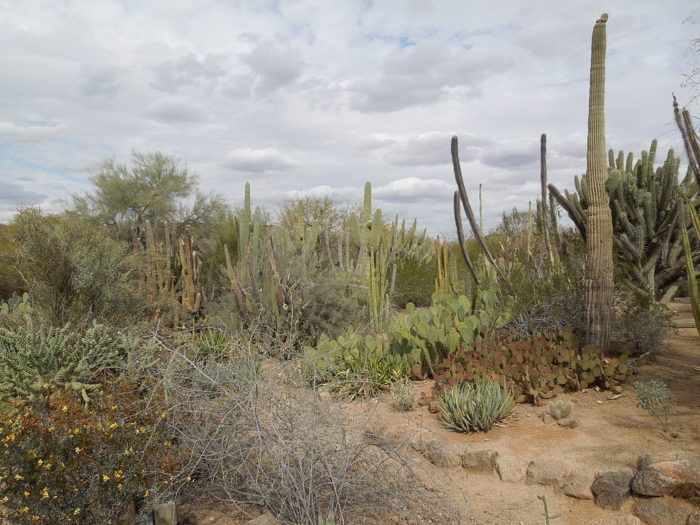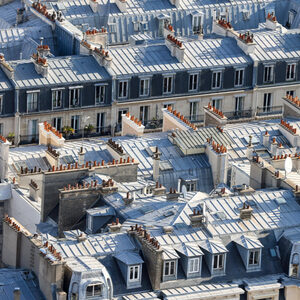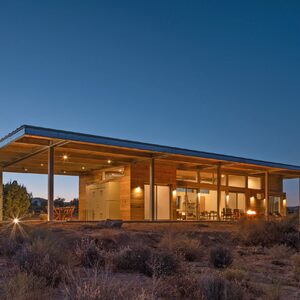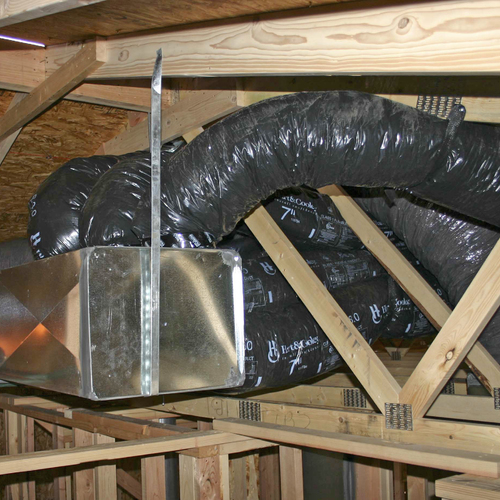
Image Credit: Wikimedia
If you have problems dealing with the heat, you probably wouldn’t like the desert Southwest, especially when conventional air conditioning is simply too expensive to use on a regular basis.
That seems to be the case for a GBA reader who’s trying to learn more about building in a climate where the challenge of staying cool far outweighs the minor and occasional inconvenience of staying warm.
“I live in the low desert southwest near Phoenix,” Anneal G writes in a post at GBA’s Q&A Forum. “Living is very different here than in cold weather areas. And very different than Florida or humid areas of Texas.”
Outside temperatures are more than 100°F in the shade for five or six months at a stretch, and may hit 115°F. At night, low temperatures may be only 95°F for a couple of months. Humidity is very low, and there are few drought-resistant trees to help.
A lot of people work at home, and few of them set their air conditioners to anything less than 79°F.
“We need to keep heat out rather than keep in or keep cool in and heat out, and this is apparently handled different than in cold weather,” Anneal asks. “But how? That is what I would like to know.
“I am not looking for perfection like the Passivhaus. Just what should an average person with a low-to-medium budget really ask for to build a basic energy-efficient home in my low desert environment?”
Anneal’s query is the focus of this Q&A Spotlight.
Start by orienting the house correctly
GBA senior editor Martin Holladay suggests that Anneal follow the recommendations in one of his articles, Hot-Climate Design. In that article, Holladay recommended that homes in hot climates be oriented…
Weekly Newsletter
Get building science and energy efficiency advice, plus special offers, in your inbox.

This article is only available to GBA Prime Members
Sign up for a free trial and get instant access to this article as well as GBA’s complete library of premium articles and construction details.
Start Free TrialAlready a member? Log in















13 Comments
Solar screens?
Any experience w/ solar screens like Pfifer Sun-Tex? I guess if he's building from scratch, he has the chance to do proper overhangs, and might not need that, but maybe it's a decent retrofit approach?
How does an architect or builder guarantee performance?
Scott,
How would an architect or builder guarantee the performance of their work? Would you give us some examples please?
I read with interest your last bit of advice to your readers who want to have a home built for themselves. You wrote: “Look for architects or builders who are willing to guarantee the performance of their work.”
While I agree that this is good advice to prospective home buyers, I wonder if that is even possible. I recall at one time in the past there was a builder in the Chicago suburbs who built homes that came with a guarantee related to energy usage (efficiency).
No longer in the Chicago area, this builder currently has two communities in Texas and their website promotes the builder as “one of the nation's foremost leaders in residential, energy-efficient construction, as well as a pioneer in green-building.” I no longer see on their website any mention of any performance guarantee for their current product.
So, I wonder if anyone has ever tackled the challenge of actually finding the architect or builder who would even consider guaranteeing the performance of their work. I know that many articles aimed at builders recommend that they write performance specifications for their trades (subcontractors), but that too is a really challenging bit of advice. Just how many HVAC contractors would ever venture a performance guarantee? It just does not seem practical when so much depends on the successful performance of the building envelope and the workmanship of many other contractors whom they have no control over.
On performance guarantees
John,
It was actually Peter Yost who suggested looking for an architect or builder who would guarantee the performance of their houses.
Still, I spoke with an architect in Louisville, Kentucky, last week who guarantees heating and cooling costs will be $45 per month per 1000 sq. ft. of floor area. He is Gary Watrous of Watrous Associates Architects, who specializes in passive solar designs.
There may very well be others who do the same thing, even if the specifics are different.
Count me out
I sure wouldn't guarantee building performance unless the owner promised not to live there. Occupant behaviour is too large a determinant of energy use. Talk to landlords who include utility costs in the rent for some real world experience on how that can effect behaviour.
When you're hot, you're hot
Scott, good article on the design demands of a truly hot environment.
Eric has speculated on the value of solar screens in a properly oriented and designed new building. When it's 95F overnight and 115F during the day, screens and low shgc windows may help stay lower in that range but most homeowners I know would be begging for thermal relief. One item that might be overlooked: When the sun is bright on a hot day and even if the window is fully shaded by overhang, it's possible to feel radiant heat through a 1990s vintage window. Stand next to the window (room at say 75F) with a magazine or solid object in hand. Close your eyes and pass the magazine between your face and the window. The difference you feel is influenced by indirect light from semi-reflective surfaces outside. In the Southwest, the South side front yard may be a patch of sand and stone; maybe a cactus. There's no lush lawn nor bushes nor trees to blunt the sun's relentless scorching. Placement of a solar screen or grate outside the window can reduce this effect and if the sun shines directly on the window at times, the window treatment serves double duty. If a grate or screen is incorporated in a shutter, the device can be stored in place. A decorative shade sail could reduce some of the indirect heating as well. Of course, if we shift to retrofit instead of new construction, window treatments can be a cost effective option and LBNL is said to have a study that will quantify the options, the economics, and even some of the intangibles.
Somewhere on Anneal's list I'd also look for a cool roof option.
performance guarantees
An architect would have to be crazy to provide an energy performance guarantee. He or she has little or no control over whether the builder complies with plans and specs. A few observation visits during construction are not enough to ensure the design gets built as it is drawn.
I suspect the architect's professional liability insurer would not cover such a guarantee.
As Malcolm points out, the homeowner is a big uncertainty. I can envision an owner in Vermont setting the thermostat at 75 in January, while sleeping with the window open.
When you're hot, you're hot, EXCEPT...
Its summertime in southern Arizona and, yes, it gets hot just like northwest Phoenix area.
Is it possible to be cool in a home where ambient temps ALWAYS hover around 75F? without a forced air system cycling intermittently throughout the 24 hour day? How could this be?
A well insulated ice chest with a block of ice will maintain cool temps for a longgggggg time. It's as simple as that.
The same is true for a house (ice chest) and the temperature controlled concrete floor (block of ice).
The enormous thermal mass capacity of a 4.5" thick slab for the entire home does just that, noiselessly, consistently, evenly and everywhere in the home - no varying and intermittent micro climates created by a blowing forced air system. And, with a 3kWh PV system the electric bills have been April, May, around $12 each month. June was just under $28 (almost half was standard customer service charges). July is coming soon but probably will be around $40.
Thanks!
Wow, thanks guys. I am so grateful for you taking me seriously.
I only just saw this after posting on "Designing Houses That Keep Their Cool"
Posted on Jul 4 2013 by Alex Wilson
Thanks again.
Post from another blog
This is comment I posted on "Designing Houses That Keep Their Cool" Posted on Jul 4 2013 by Alex Wilson.
https://www.greenbuildingadvisor.com/blogs/dept/energy-solutions/designing-houses-keep-their-cool
Figured this is a better thread for it.
"Phoenix is not high desert
by Anneal G
Thank you for taking the time to consider warm weather areas.
The low altitude southwest is a unique situation. It is not high desert like Las Vegas or even most of Tucson. It is frustrating that low altitude and high desert are generally combined into the same environment. They are not. Yet the population here is fairly significant. According to World Population Review, Phoenix is the 5th most populous city in the United States and the Phoenix metropolitan area is home to 4.33 million people in 2013. I dare say in the winter it doubles where I live with “snowbirds” or winter visitors so, as a guess, it may be 1/3 higher in the general metropolitan area in the winter?
But, the winter isn’t an issue here. It’s beautiful, open window time. It’s the long hot season that is an issue. I don’t think anyone living here year round complains that their inside temp is too hot at 79-80F with ceiling fans running, in high summer. When it accidently gets to 77F…burr. Seriously.
My non-professional observation is: it is the sun that is hot here and the air is much cooler. I know that sounds stupid but it just feels as though the sun is hotter here. Even in the winter, when you get in the car in the late morning, it is hot. When it is 105F in the shade it is at least 120F in the sun. As soon as it gets a little cloudy ;-) the temp drops dramatically to maybe 100F in the shade so to me keeping the sun off the bldg. via roof overhang or something makes a big difference.
I would like to know if something like a second wall/vertical louver fence a specific distance from the house would provide some kind of protection. Not just, yea, anything would help, but some specific scientific insulating/cooling value? Like if it is 12” from bldg it acts like magnifier holding the heat in but if it is 18” it would protect but 24” it does nothing. It seems to me that might be inexpensive if it would work. And some heat reflective surface for the exterior siding that doesn’t blind you or reflect heat onto the neighbors house? The article mentioned roof materials certified by the Cool Roof Rating Council or the Energy Star Roof program. Can they be used as siding?"
They Make Shade Fabric
Coolaroo fabric is quite economical. It allows just the right amount of air through it, which is critical.
http://www.coolaroousa.com/en/shade-sails
You're right that the sun is the problem, but a well insulated house just needs shade on the windows.
For a poorly insulated house, it might be cheaper to shade it than insulate it.
Shading exterior walls...
Do you need to shade a highly insulated ice chest that has a block of ice in it? No.
Swamp coolers, mini splits and HVAC
I'm renovating a 1950's house in the semi-high desert (2,700 feet, stays over 80 at night in the summer). We've gone to some trouble to improve the orientation of the windows, as well as the insulation of the house, including furring in 2x4 walls with polyiso foam and 1x sticks to accept almost 6" of insulation. However, air sealing the existing stucco and roof connection will be a challenge.
I'm trying to decide between the traditional low-tech green solution most people use around here, evaporative coolers, or a newfangled mini-split heat pump.
Swamp coolers: use very little electricity to run fan and pump, add comfortable moisture to the inside air, and can use quite a bit of water - at least 10 gallons a day (though the bleed-line water can be recycled to water plants). If the air outside is fresh, it keeps the inside air fresh because it requires an open window at the other end of the house, and keeps air moving through. However, when there is smoke from a nearby wildfire for a week, or pollen, there is no way to stay cool without getting full exposure to the elements. If the swamp cooler blows directly into the house, it's hard to air seal in the winter. If ducted, the ducts would need to run through unconditioned attic in our case. Requires annual maintenance.
Mini split AC: Expensive to install; dries the air, which can can exacerbate nosebleeds in the spring and fall; doesn't use water, probably uses more electricity than the swamper, though I'm having trouble pinning down any real numbers; we're in a small town, so there are only a couple installers, I'm not sure how good they are at properly sizing systems.
The mini-split of course could also provide heat in the winter. If we get a swamp cooler, we'll also get a wood stove. We have access to a lot of free wood, and probably a free used swamp cooler, so the only costs will be installing everything. At around $5k to install (vs. around $1500 for the swamer/wood stove), I suspect the mini-split will take a very long time to pay itself back. However, we want to do the right thing for the long haul.
What do you think?
My other question is, does an HVAC make sense for a house like this (small, not that tight)? Or is it OK to just have exhaust fans over the stove and in the bathroom?
Response to Reanna Adler
Reanna,
Q. "My other question is, does an HVAC make sense for a house like this (small, not that tight)? Or is it OK to just have exhaust fans over the stove and in the bathroom?"
A. I'm not sure what you mean by "an HVAC." Most people use the phrase "HVAC equipment" -- it refers to heating, ventilating, and air conditioning equipment. Many of the components you talk about -- including a swamp cooler, a minisplit heat pump, a wood stove, and exhaust fans -- are all elements of your HVAC system. Whichever appliances you choose, you will always have an HVAC system -- unless you want to live in a house with no heat, no cooling equipment, and no fans.
I think that you understand the pluses and minuses of the evaporative cooler vs. minisplit debate. The decision is up to you. For more perspective on this issue, see this article: Saving Energy With an Evaporative Cooler.
Log in or become a member to post a comment.
Sign up Log in